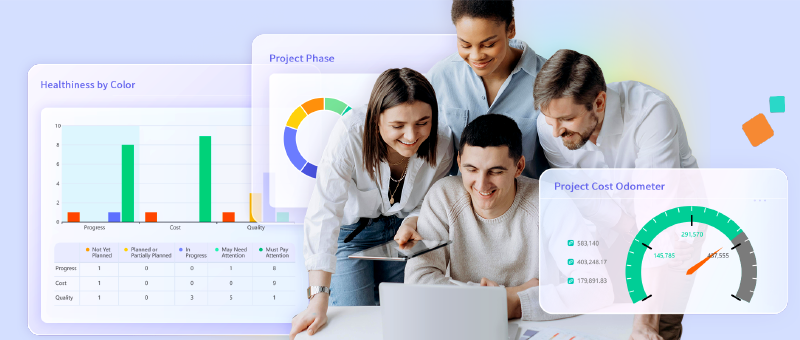Project Business Management

Project business involves professional services, business process outsourcing, IT outsourcing, construction, R&D, manufacturing, subcontracting, installation, modernization, periodic maintenance, moving and decommissioning products. In most cases, labor, equipment and materials are used simultaneously. Examples include installing turbines for energy customers, or implementing control systems in new buildings for real estate developers. Tasks are interdependent and often require multiple skill sets (eg, mechanical skills for installing physical equipment and electrical skills for commissioning). A project is considered successful if the company delivers it on time, within scope, and on budget.
Project businesses can generate a high percentage of revenue for companies with a large multi-skilled mobile workforce. In order to achieve higher profits, companies only need to extract the maximum value from each item. For many companies, this means improved quoting, scope management, revenue management and resource management, as well as improved delivery efficiency. It also means using a different way of thinking.
Project businesses often encounter the following five challenges, which must be overcome to realize their full profit potential. A high-quality experience sets the tone for customers’ continued expectations, increasing their likelihood of purchasing additional products and services.
Turn scope into an executable solution
Challenge:
Once the sale is done and the scope is agreed with the client, the handover from the sales team to the team responsible for the solution (including design and planning) goes wrong and the resulting inconsistency means that the scope (and contractual agreement) is not included in the solution s project. In addition, there are often large gaps between what was planned and what actually happened because the deliverables process lacked proper internal review and external acceptance. Many projects ostensibly have internal reviews and external acceptances, but these only happen in the final stages of the project. Since decisions are often based on a previous decision, it is very difficult to change the initial decision in the end, resulting in dissatisfied customers and even lawsuits.
Solution:
Use  All-in-one to track from target scope to project plan in real time, and from project plan to internal review and external acceptance of each internal or external deliverable. In terms of quality and deviation control, the first focus is on the granularity of the deliverables reviewed/accepted, and the second focus is on the appropriateness of the review/acceptance person. If the granularity is too coarse or if the review/acceptance does not happen until the final delivery, there will be situations where it is difficult to revise the initial decision. The deliverable review/acceptance of
All-in-one to track from target scope to project plan in real time, and from project plan to internal review and external acceptance of each internal or external deliverable. In terms of quality and deviation control, the first focus is on the granularity of the deliverables reviewed/accepted, and the second focus is on the appropriateness of the review/acceptance person. If the granularity is too coarse or if the review/acceptance does not happen until the final delivery, there will be situations where it is difficult to revise the initial decision. The deliverable review/acceptance of  All-in-one starts from the lowest level, and is reviewed/accepted layer by layer until the final deliverable. As for review/acceptance personnel, the system has the latest talent pool skill information to help project managers complete talent selection. The system also has an automatic audit trail that records reviewer’s/acceptor’s comments and approval decisions. Everything is tractable, so the reviewer/acceptance person does not dare to be sloppy.
All-in-one starts from the lowest level, and is reviewed/accepted layer by layer until the final deliverable. As for review/acceptance personnel, the system has the latest talent pool skill information to help project managers complete talent selection. The system also has an automatic audit trail that records reviewer’s/acceptor’s comments and approval decisions. Everything is tractable, so the reviewer/acceptance person does not dare to be sloppy.
Challenge:
The ability of the project team to overcome interdependencies is critical to meeting schedule commitments. Delays in the completion of activities on the critical path can result in delays in the overall project schedule. Typical interdependencies involve:
- Materials and equipment—these may not be available due to ineffective planning or unexpected delays in the supply chain.
- Internal labor—inadequate backlog planning and capacity management can impact labor availability. In many cases, technicians have very specific skills and do not have cross-skills to perform various jobs.
- Subcontracted labor—inconsistent contract terms or the failure of incentives to align with project priorities often results in the unavailability of subcontracted labor.
Solution:
Use  All-in-one to provide automatic inter-activity predecessor dependency management and critical path management, mandatory and non-mandatory dependency management between deliverables, skill matching management of resources, time conflict and overload management, and dependency management of outsourced sub-projects.
All-in-one to provide automatic inter-activity predecessor dependency management and critical path management, mandatory and non-mandatory dependency management between deliverables, skill matching management of resources, time conflict and overload management, and dependency management of outsourced sub-projects.
Find the right people with the right skills at the right time
Challenge:
Matching the right resources to the right projects is a significant challenge, as much of the low-skilled or non-specialized work is subcontracted to external parties and requirements vary widely. Our experience shows that to properly allocate skill costs, project managers need a rigorous resource planning system and rate schedule. Without tight controls, project managers tend to use their favorite resources (or hide them from other managers), which reduces utilization across the board. Projects often leave unbalanced teams with wrong skill sets or skill levels (for example, too many high-cost professional mechanics and not enough general technicians). Or companies may be forced to delay starting until the right mix of labor is available. Both of these outcomes reduce project profits.
Solution:
Use  All-in-one to build a talent pool of the entire enterprise and its resource suppliers. The talent pool has the latest available time, site and skills for each resource, and the system can automatically match the selection criteria (search criteria) for project managers to choose.
All-in-one to build a talent pool of the entire enterprise and its resource suppliers. The talent pool has the latest available time, site and skills for each resource, and the system can automatically match the selection criteria (search criteria) for project managers to choose.
Profit from execution
Challenge:
Project business is an execution game. Especially for project-based services, customer changes make execution plans difficult. Even if a company can overcome the above challenges and successfully set up each project, the company will still lose money if the project team fails to execute as planned. Key challenges include managing customer scope changes. Companies expect customers to request changes, and in fact this happens on most projects. While this is unavoidable, companies often execute scope changes without payment due to bad changes.
Solution:
 All-in-one provides real-time scope management, cost management (including resource cost and procurement/outsourcing cost) and change management. Since double-entry accounting needs to be manually judged for credit/debit, it is impossible to complete it in real time. Therefore, traditional project management systems and financial systems cannot display the impact of changes on cost and profit in real time. Even if no demand changes occur, the real cost consumption figures lag far behind (typically weeks). When a demand change occurs, it is even impossible to timely track the time and resource changes and cost impact of each activity. If you assume that this problem cannot leave double-entry accounting, it will be difficult to solve. The reason why double-entry accounting was invented in 1494 was that there was no computer, and it would be hard for humans to use single-entry accounting without making mistakes in the numerous calculations of multiple subjects. The worst case was that even if you made a mistake in the ledger calculation, you could not know it. Using the double-entry accounting method, you could re-check and correct errors in the calculation of the ledger when the final credit and debit of the ledger were not equal. People are not computers, and there are good reasons not to use single-entry accounting. But computers are not people. As long as calculations are complicated and error-prone, single-entry accounting can be used.
All-in-one provides real-time scope management, cost management (including resource cost and procurement/outsourcing cost) and change management. Since double-entry accounting needs to be manually judged for credit/debit, it is impossible to complete it in real time. Therefore, traditional project management systems and financial systems cannot display the impact of changes on cost and profit in real time. Even if no demand changes occur, the real cost consumption figures lag far behind (typically weeks). When a demand change occurs, it is even impossible to timely track the time and resource changes and cost impact of each activity. If you assume that this problem cannot leave double-entry accounting, it will be difficult to solve. The reason why double-entry accounting was invented in 1494 was that there was no computer, and it would be hard for humans to use single-entry accounting without making mistakes in the numerous calculations of multiple subjects. The worst case was that even if you made a mistake in the ledger calculation, you could not know it. Using the double-entry accounting method, you could re-check and correct errors in the calculation of the ledger when the final credit and debit of the ledger were not equal. People are not computers, and there are good reasons not to use single-entry accounting. But computers are not people. As long as calculations are complicated and error-prone, single-entry accounting can be used.  All-in-one adopts a single-entry method to offer a real-time comprehensive management ledger. Users can click on the ledger numbers to see their composition or from which receipts, so the above challenges can be easily solved.
All-in-one adopts a single-entry method to offer a real-time comprehensive management ledger. Users can click on the ledger numbers to see their composition or from which receipts, so the above challenges can be easily solved.
























































































































